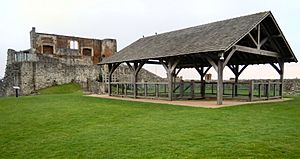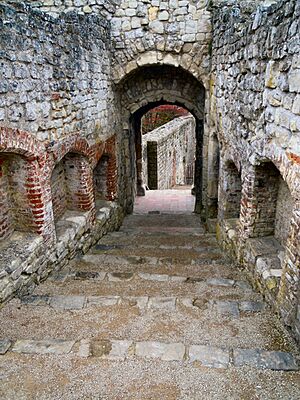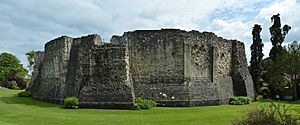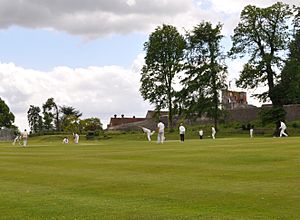Farnham Castle facts for kids
Quick facts for kids Farnham Castle |
|
|---|---|
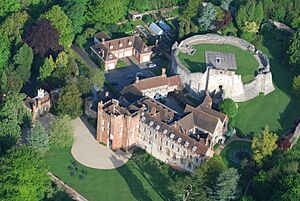
Aerial view
|
|
|
Listed Building – Grade I
|
|
| Official name: Farnham Castle (comprising castle buildings to the south only), Castle Hill | |
| Designated | 26 April 1950 |
| Reference no. | 1044677 |
Farnham Castle is a very old castle in Farnham, England. It was built way back in the 1100s! For over 800 years, important church leaders called the Bishops of Winchester lived here.
Contents
History of Farnham Castle
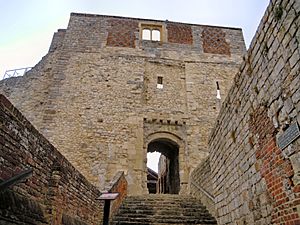
Farnham Castle was built in 1138 by a powerful bishop named Henri de Blois. He was even the grandson of William the Conqueror! The castle became the home of the Bishops of Winchester for more than 800 years.
The first castle was pulled down by King Henry II in 1155 after a time of trouble called 'the Anarchy'. But don't worry, it was rebuilt soon after, in the late 1100s and early 1200s.
In the early 1400s, a famous church leader named Cardinal Henry Beaufort lived at the castle. He was involved in the trial of Joan of Arc in France in 1431. That's why there's a church in Farnham named after her, St Joan of Arc's Church.
Castle Design and Features
The castle's design shows how building styles changed over hundreds of years. This makes it a very important historical building in southern England. It's a strong stone castle built like a motte and bailey fortress. A "motte" is a big hill, and a "bailey" is a walled area.
The large hill (motte) was built around the strong foundations of an older Norman tower. Then, a shell keep was built around the top of the motte. A shell keep is a circular wall that protects the top of the hill. It had strong buttress turrets and a small gatehouse.
Next to the motte is a triangular inner bailey. This area had nice buildings where people lived and a brick entrance tower from the 1400s. The outer bailey had a huge curtain wall with square towers, a gatehouse from the 1200s, and a big ditch for defense.
Famous Visitors and Events
Queen Mary I stayed at Farnham Castle in July 1554, just before her wedding to Philip of Spain.
Later, in July 1609, the castle's stables burned down when King James, his wife Anne of Denmark, and their son Prince Henry were visiting.
The castle was partly destroyed again in 1648, after the English Civil War. Since then, more buildings have been added to the castle grounds. Some of the most impressive ones were built by Bishop George Morley in the 1600s.
The castle is surrounded by beautiful gardens that cover about 5 acres (20,000 square meters). These gardens look out over the town of Farnham.
Farnham Castle in World War II
During the Second World War, Farnham Castle was home to a special training center. It was called the Camouflage Development and Training Centre (CDTC). Here, artists like Roland Penrose and Julian Trevelyan, and even a magician named Jasper Maskelyne, learned how to use military camouflage. Camouflage is the art of hiding things by making them blend in with their surroundings.
Since 1962, the castle has been used as a place for training and conferences, especially for people from different cultures.
Visiting Farnham Castle
Thanks to help from the Heritage Lottery Fund, the castle's keep and the Bishop's Palace have been fully restored. Farnham Castle now manages these areas.
The keep re-opened in July 2010. It has lots of new information about the castle's history. There's also an exhibition that tells the story of "900 Years of Living History" at Farnham Castle.
English Heritage looks after the keep, but Farnham Castle helps visitors explore it. Entry to the keep is free! Local guides also offer tours of the Bishop's Palace on certain days, but there is a charge for those tours.
See also


